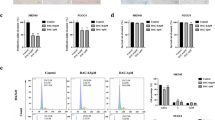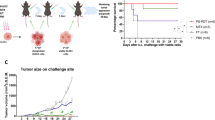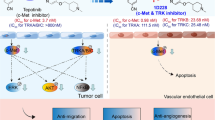Abstract
1,2:5,6-dianhydrogalactitol (DAG) is a hexitol epoxide with marked antitumor activity against multiple types of cancer cells, but the molecular mechanisms by which DAG functions as an antitumor agent is largely unknown. In this study, we investigated the inhibitory effects of DAG on human glioma cell growth in vitro and in vivo and uncovered the underlying molecular mechanisms. Treatment with DAG (120 μmol/L) dose-dependently inhibited the proliferation and colony formation in human glioma cell lines LN229, U251, and U87MG in vitro. DAG (1, 2, 5 μmol/L) induced cell cycle arrest at G2/M phase in the 3 glioma cell lines in a dose-dependent manner. The signaling pathways involved in DAG-caused cell cycle arrest was further analyzed in LN229 cells, which revealed that DAG dose-dependently activated two parallel signaling cascades, ie, the p53-p21 cascade and the CDC25C-CDK1 cascade. DAG also significantly enhanced the radiosensitivity of LN229 cells as shown in the clonogenic assay. In nude mice bearing subcutaneously xenografted LN229 glioma, administration of DAG (5 mg/kg, iv, twice per week for 6 weeks) effectively suppressed the growth of xenografted tumors: the relative tumor growth rate (T/C) was reduced to 22.38%, and the tumor growth inhibitory rate (TGI) was 83.58% (P<0.01). In addition, DAG administration significantly activated the CDC25C-CDK1 cascade in the xenografted tumors. In conclusion, DAG inhibited human glioma cell growth in vitro and in vivo by inducing cell cycle arrest at G2/M phase. Two parallel cascades are activated and involved in the cell cycle arrest.
Similar content being viewed by others
Log in or create a free account to read this content
Gain free access to this article, as well as selected content from this journal and more on nature.com
or
References
Louis DN, Ohgaki H, Wiestler OD, Cavenee WK, Burger PC, Jouvet A, et al. The 2007 WHO classification of tumours of the central nervous system. Acta Neuropathol 2007; 114: 97–109.
Thomas AA, Brennan CW, DeAngelis LM, Omuro AM . Emerging therapies for glioblastoma. JAMA Neurol 2014; 71: 1437–44.
Gilbert MR, Wang M, Aldape KD, Stupp R, Hegi ME, Jaeckle KA, et al. Dose-dense temozolomide for newly diagnosed glioblastoma: a randomized phase III clinical trial. J Clin Oncol 2013; 31: 4085–91.
Hegi ME, Diserens AC, Gorlia T, Hamou MF, de Tribolet N, Weller M, et al. MGMT gene silencing and benefit from temozolomide in glioblastoma. N Engl J Med 2005; 352: 997–1003.
Cahill DP, Levine KK, Betensky RA, Codd PJ, Romany CA, Reavie LB, et al. Loss of the mismatch repair protein MSH6 in human glioblastomas is associated with tumor progression during temozolomide treatment. Clin Cancer Res 2007; 13: 2038–45.
Marchesi F, Turriziani M, Tortorelli G, Avvisati G, Torino F, De Vecchis L . Triazene compounds: mechanism of action and related DNA repair systems. Pharmacol Res 2007; 56: 275–87.
Omuro A, DeAngelis LM . Glioblastoma and other malignant gliomas: a clinical review. JAMA 2013; 310: 1842–50.
Batchelor TT, Mulholland P, Neyns B, Nabors LB, Campone M, Wick A, et al. Phase III randomized trial comparing the efficacy of cediranib as monotherapy, and in combination with lomustine, versus lomustine alone in patients with recurrent glioblastoma. J Clin Oncol 2013; 31: 3212–8.
Chinot OL, Wick W, Mason W, Henriksson R, Saran F, Nishikawa R, et al. Bevacizumab plus radiotherapy-temozolomide for newly diagnosed glioblastoma. N Engl J Med 2014; 370: 709–22.
Gilbert MR, Dignam JJ, Armstrong TS, Wefel JS, Blumenthal DT, Vogelbaum MA, et al. A randomized trial of bevacizumab for newly diagnosed glioblastoma. N Engl J Med 2014; 370: 699–708.
Eagan RT, Childs DS Jr, Layton DD Jr, Laws ER Jr, Bisel HF, Holbrook MA, et al. Dianhydrogalactitol and radiation therapy. Treatment of supratentorial glioma. JAMA 1979; 241: 2046–50.
Levin VA, Freeman-Dove MA, Maroten CE . Dianhydrogalactitol (NSC-132313): pharmacokinetics in normal and tumor-bearing rat brain and antitumor activity against three intracerebral rodent tumors. J Natl Cancer Inst 1976; 56: 535–9.
Eckhardt S, Csetenyi J, Horvath IP, Kerpel-Fronius S, Szamel I, Institoris L, et al. Uptake of labeled dianhydrogalactitol into human gliomas and nervous tissue. Cancer Treat Rep 1977; 61: 841–7.
Eagan RT, Moertel CG, Hahn RG, Schutt AJ . Phase I study of a five-day intermittent schedule for 1,2:5,6-dianhydrogalactitol (NSC-132313). J Natl Cancer Inst 1976; 56: 179–81.
Perry MC, Moertel CG, Schutt AJ, Reitemeier RJ, Hahn RG . Phase II studies of dianhydrogalactitol and VP-16-213 in colorectal cancer. Cancer Treat Rep 1976; 60: 1247–50.
Espana P, Wiernik PH, Walker MD . Phase II study of dianhydrogalactitol in malignant glioma. Cancer Treat Rep 1978; 62: 1199–200.
Institoris E . In vivo study on alkylation site in DNA by the bifunctional dianhydrogalactitol. Chem Biol Interact 1981; 35: 207–16.
Steino A, Bacha JA, Garner WJ, Kanekal S, Siddik ZH, Brown DM . Abstract B252: The unique mechanism of action of VAL-083 may provide a new treatment option for some chemo-resistant cancers. Mol Cancer Ther 2014; 12 (11_Supplement).
Hirose Y, Berger MS, Pieper RO . p53 effects both the duration of G2/M arrest and the fate of temozolomide-treated human glioblastoma cells. Cancer Res 2001; 61: 1957–63.
Yan L, Donze JR, Liu L . Inactivated MGMT by O6-benzylguanine is associated with prolonged G2/M arrest in cancer cells treated with BCNU. Oncogene 2005; 24: 2175–83.
Geard CR, Jones JM, Schiff PB . Taxol and radiation. J Natl Cancer Inst Monogr 1993; (15): 89–94.
Bunz F, Dutriaux A, Lengauer C, Waldman T, Zhou S, Brown JP, et al. Requirement for p53 and p21 to sustain G2 arrest after DNA damage. Science 1998; 282: 1497–501.
Zhan Q, Antinore MJ, Wang XW, Carrier F, Smith ML, Harris CC, et al. Association with Cdc2 and inhibition of Cdc2/Cyclin B1 kinase activity by the P53-regulated protein Gadd45. Oncogene 1999; 18: 2892–900.
Hermeking H, Lengauer C, Polyak K, He TC, Zhang L, Thiagalingam S, et al. 14-3-3sigma is a p53-regulated inhibitor of G2/M progression. Mol Cell 1997; 1: 3–11.
Pearl LH, Schierz AC, Ward SE, Al-Lazikani B, Pearl FMG . Therapeutic opportunities within the DNA damage response. Nat Rev Cancer 2015; 15: 166–80.
Holohan C, Van Schaeybroeck S, Longley DB, Johnston PG . Cancer drug resistance: an evolving paradigm. Nat Rev Cancer 2013; 13: 714–26.
Banin S, Moyal L, Shieh S, Taya Y, Anderson CW, Chessa L, et al. Enhanced phosphorylation of p53 by ATM in response to DNA damage. Science 1998; 281: 1674–7.
Taylor WR, Stark GR . Regulation of the G2/M transition by P53. Oncogene 2001; 20: 1803–15.
Hirao A, Kong YY, Matsuoka S, Wakeham A, Ruland J, Yoshida H, et al. DNA damage-induced activation of p53 by the checkpoint kinase Chk2. Science 2000; 287: 1824–7.
Charrier-Savournin FB, Chateau MT, Gire V, Sedivy J, Piette J, Dulic V . p21-Mediated nuclear retention of cyclin B1-Cdk1 in response to genotoxic stress. Mol Biol Cell 2004; 15: 3965–76.
Eagan RT, Creagan ET, Bisel HF, Layton DD Jr, Groover RV, Herman RC Jr . Phase II studies of dianhydrogalactitol-based combination chemotherapy for recurrent brain tumors. Oncology 1981; 38: 4–6.
Shih KC, Patel MR, Butowski N, Falchook G, Kizilbash SH, Bacha JA, et al. Phase I/II study of dianhydrogalactitol in patients with recurrent malignant glioblastoma. AACR Annual Meeting 2016.
Acknowledgements
This work was supported by grants from the National Science and Technology Major Project (2012ZX09302-003 and 2015ZX09102005). We thank Guangxi Wuzhou Zhongheng Group Co, Ltd (Wuzhou, China) for kindly providing us 1,2:5,6-dianhydrogalactitol and related information. In addition, we thank Dr Yi-zheng WANG for his constructive suggestions for this study.
Author information
Authors and Affiliations
Corresponding authors
Rights and permissions
About this article
Cite this article
Peng, C., Qi, Xm., Miao, Ll. et al. 1,2:5,6-dianhydrogalactitol inhibits human glioma cell growth in vivo and in vitro by arresting the cell cycle at G2/M phase. Acta Pharmacol Sin 38, 561–570 (2017). https://doi.org/10.1038/aps.2016.154
Received:
Accepted:
Published:
Issue date:
DOI: https://doi.org/10.1038/aps.2016.154
Keywords
This article is cited by
-
DNA Repair Mechanisms and Therapeutic Targets in Glioma
Current Oncology Reports (2021)



